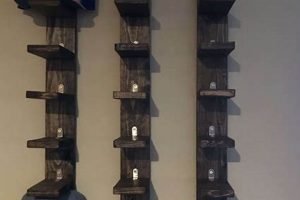Creating personal adornments for the wrist involves a crafting process where individuals assemble various materials to fashion a decorative band. This self-directed activity typically utilizes beads, strings, cords, or other embellishments to produce a unique piece of wearable art. A common example involves threading colorful beads onto a stretch cord to create a vibrant, elastic wristband.
The act of constructing wrist ornaments yields numerous advantages, encompassing cost-effectiveness, personalization, and therapeutic engagement. Historically, self-made wristbands have served as symbols of friendship, remembrance, or personal expression across diverse cultures. The ability to tailor the design to specific tastes and occasions enhances the significance of these items, making them more than mere accessories.
The subsequent sections will delve into specific techniques for wrist adornment construction, explore the diverse array of materials suitable for this endeavor, and provide guidance on achieving professional-looking results in self-directed projects.
Techniques for Bracelet Creation
The following recommendations aim to enhance the quality and longevity of handcrafted wrist ornaments.
Tip 1: Material Selection. Prioritize the selection of durable and appropriate materials. For instance, when working with elastic cords, opt for options specifically designed for jewelry-making to prevent premature breakage.
Tip 2: Knot Security. Secure all knots meticulously. Employ a surgeon’s knot or apply a small amount of jewelry adhesive to reinforce the closure and prevent unraveling.
Tip 3: Bead Spacing. Maintain consistent bead spacing to ensure a uniform and aesthetically pleasing appearance. Utilizing a bead board can aid in achieving even distribution.
Tip 4: Color Harmony. Consider color theory principles when choosing beads or embellishments. A well-coordinated palette will enhance the overall visual appeal of the finished piece.
Tip 5: Size Accuracy. Accurately measure wrist circumference before commencing construction. Add approximately half an inch to the measurement to allow for comfortable movement.
Tip 6: Tool Proficiency. Familiarize yourself with the proper use of jewelry-making tools, such as pliers and crimping tools. Incorrect usage can damage materials or compromise structural integrity.
Tip 7: Design Planning. Develop a design plan before commencing the construction process. Sketching a preliminary design can help visualize the final product and prevent errors.
Adhering to these guidelines promotes the creation of durable, visually appealing, and personalized wrist adornments.
The subsequent section will provide guidance on sourcing appropriate materials for this endeavor.
1. Material Durability
Material durability is a paramount consideration in the creation of wrist ornaments. The longevity and resilience of these personal accessories are directly contingent upon the properties of the selected components. Insufficient durability compromises the integrity and aesthetic appeal of the finished product.
- Tensile Strength of Cords and Wires
The tensile strength of cords and wires dictates their resistance to breakage under tension. Materials with low tensile strength, such as inexpensive crafting threads, are prone to snapping during wear or construction. Conversely, high-tensile options, like specialized beading wire or paracord, offer superior resistance to stress, extending the lifespan of the wrist ornament.
- Resistance to Abrasion and Wear
Wrist ornaments are subjected to constant friction against skin and clothing. Materials susceptible to abrasion, such as painted wood beads or soft acrylic, may exhibit premature wear and loss of surface finish. Robust materials, including gemstones or high-quality glass beads, demonstrate greater resistance to abrasion, maintaining their original appearance for an extended period.
- Chemical Stability and Corrosion Resistance
Exposure to moisture, sweat, and environmental pollutants can induce corrosion or degradation in certain materials. Metal components, particularly those composed of base metals, are vulnerable to tarnishing or rusting. Opting for corrosion-resistant materials, such as stainless steel or precious metals, mitigates these risks and preserves the aesthetic integrity of the wrist ornament.
- Colorfastness and UV Resistance
Prolonged exposure to sunlight can cause fading or discoloration in certain materials. Dyes used in fabrics, beads, or cords may be susceptible to ultraviolet degradation. Selecting materials with inherent colorfastness or applying UV-protective coatings can minimize fading and ensure the wrist ornament retains its vibrant appearance.
The careful evaluation of material durability is essential for producing wrist ornaments that withstand the rigors of daily wear and maintain their aesthetic value over time. Prioritizing high-quality, resilient materials translates to a longer-lasting, more satisfying crafting experience and a more cherished final product.
2. Closure Security
The security of a bracelet’s closure mechanism directly influences its functionality and longevity. A deficient closure presents the risk of unintentional detachment, resulting in loss or damage to the handcrafted item. The correlation between a robust closure and a positive user experience is undeniable; a secure fastener instills confidence, while a faulty one fosters frustration and diminishes the perceived value of the bracelet.
Various closure types are employed in bracelet construction, each with inherent advantages and disadvantages regarding security. Examples include lobster clasps, toggle clasps, magnetic clasps, and adjustable sliding knots. Lobster clasps, known for their reliable spring mechanism, offer a secure hold when properly engaged. Conversely, magnetic clasps, while convenient, may be susceptible to accidental opening due to external forces or weak magnetic fields. Adjustable sliding knots provide a customizable fit and, when correctly tied, offer adequate security. The selection of an appropriate closure mechanism must consider the bracelet’s weight, intended use, and the wearer’s dexterity.
Ultimately, the security of a handmade bracelet’s closure is a critical factor in its overall value and usability. Improper closure selection or flawed attachment can negate the time and effort invested in its creation. Careful consideration of closure type, coupled with meticulous attachment techniques, enhances the durability and ensures the intended function of the wrist ornament.
3. Aesthetic Cohesion
Aesthetic cohesion, in the context of handcrafted wrist adornments, denotes the harmonious integration of design elements to achieve a unified and visually pleasing outcome. The selection of beads, cords, clasps, and other components must reflect a deliberate artistic vision, ensuring that their colors, textures, and forms complement one another. Failure to achieve aesthetic cohesion results in a discordant and visually unappealing piece, diminishing its perceived value and detracting from its overall impact.
The importance of aesthetic cohesion extends beyond mere surface appeal; it directly influences the perceived quality and professionalism of the finished bracelet. For instance, a bracelet utilizing mismatched bead sizes and clashing colors, despite being structurally sound, will likely be viewed as amateurish. Conversely, a bracelet with meticulously chosen color palettes, balanced proportions, and thoughtful material pairings will exude a sense of refinement and artistic intent. Achieving this balance frequently involves careful planning, experimentation with different combinations, and a discerning eye for detail. Real-world examples of aesthetically cohesive bracelets often feature limited color palettes, intentional use of negative space, and repetition of design motifs to create a sense of harmony and order.
Understanding the principles of aesthetic cohesion enables creators to elevate their designs from mere assemblages of materials to expressions of personal style and artistic vision. By consciously considering color theory, texture relationships, and proportional balance, individuals can craft wrist adornments that are not only visually appealing but also reflect a deeper understanding of design principles. While challenges may arise in sourcing materials that perfectly align with a pre-determined aesthetic, the conscious pursuit of cohesion ultimately yields a superior and more satisfying final product. The principles of aesthetic cohesion can be applied across various crafting disciplines, making its understanding valuable beyond the scope of wrist adornment creation.
4. Size Accuracy
Size accuracy is a foundational element in the creation of handcrafted wrist adornments. Inaccurate sizing compromises both the comfort and aesthetic appeal of the finished piece. If a bracelet is too small, it may be uncomfortable or impossible to wear. Conversely, a bracelet that is too large may slide off the wrist or appear disproportionate. The relationship between precise measurements and a successful outcome is directly causal; accurate measurements yield a wearable and visually pleasing product, while imprecise measurements lead to dissatisfaction and potential waste of materials.
The practical significance of understanding size accuracy is evident in numerous crafting scenarios. For example, constructing a beaded bracelet requires precise knowledge of the wrist circumference to determine the appropriate number of beads. If the measurement is underestimated, the bracelet will be too tight, potentially causing discomfort or breakage. If the measurement is overestimated, the bracelet will be loose, detracting from its aesthetic appeal and increasing the risk of loss. Similarly, when crafting a macrame bracelet, accurate size calculations are essential to ensure the intricate knotting patterns align correctly and the finished bracelet fits comfortably. A bracelet crafted with a toggle clasp necessitates careful calculation of its length to avoid slippage or an overly snug fit.
In summation, size accuracy serves as an indispensable attribute in handcrafting wrist ornaments, significantly affecting both their functionality and aesthetic presentation. Neglecting precise measurements may lead to a less-than-satisfactory product, squandering time, and resources. The capability to attain precise dimensions results in a finished product that meets user comfort, visually appeasing, and exhibits professional quality. The application of size accuracy extends throughout various crafting domains, establishing it as a valuable skill. It necessitates an understanding of appropriate measurement techniques and an appreciation for its vital role in generating successful handcrafted items.
5. Ergonomic Comfort
Ergonomic comfort constitutes a critical, yet often overlooked, aspect of the handmade wrist ornament. A bracelet, regardless of its aesthetic appeal, becomes impractical if it causes discomfort to the wearer. Constant friction, pressure points, or ill-fitting components can transform a potentially cherished accessory into an object of irritation. The correlation between ergonomic design and wearer satisfaction is directly proportional; a well-designed bracelet promotes prolonged wear, while a poorly designed one is relegated to infrequent use. The impact of ergonomic considerations extends beyond physical sensation, influencing psychological perceptions of value and quality. Example: a bracelet crafted with sharp edges or overly tight beads will not only be uncomfortable but also perceived as low-quality.
The practical implications of ergonomic comfort manifest in various design choices. Utilizing lightweight materials reduces strain on the wrist, minimizing fatigue during extended wear. Employing smooth, rounded beads eliminates potential pressure points and friction against the skin. Adjustable closures, such as sliding knots or extension chains, allow for a customized fit, accommodating variations in wrist size and swelling. Careful consideration of clasp placement prevents irritation and ensures ease of use. The choice of stringing material also affects comfort; flexible, non-abrasive cords prevent chafing and allow for natural wrist movement. A common pitfall is prioritizing aesthetics over ergonomics, resulting in a visually appealing yet unwearable bracelet. The implementation of ergonomic principles requires a balanced approach, integrating both style and functionality.
In conclusion, ergonomic comfort is an indispensable component of a well-crafted wrist ornament, significantly impacting its usability and perceived value. Ignoring ergonomic considerations undermines the potential for prolonged wear and wearer satisfaction. While aesthetic appeal plays a crucial role, neglecting ergonomic factors ultimately compromises the overall quality and practicality of the bracelet. A successful wrist ornament design prioritizes both visual attractiveness and physical comfort, resulting in a cherished and frequently worn accessory. Challenges in achieving perfect ergonomics often involve balancing aesthetic preferences with practical limitations, requiring creative problem-solving and a user-centered design approach.
6. Design Complexity
The degree of intricacy inherent in a wrist adornment project directly influences the time, skill, and resources required for its completion. Design complexity encompasses various factors, including the number of components, the intricacy of the patterns, and the techniques employed in assembly. A highly complex design necessitates advanced crafting skills, specialized tools, and a significant investment of time. This, in turn, affects the feasibility of a given project for individuals with varying le
vels of crafting experience. For example, a simple beaded strand requires minimal skill and time, whereas a multi-strand macrame wrist adornment with intricate knotwork demands considerable expertise and dedication. The choice of design complexity therefore dictates the accessibility and success of a self-directed wrist ornament endeavor.
The practical significance of understanding design complexity lies in the ability to accurately assess the feasibility of a project and select appropriate designs based on one’s skill level and available resources. Attempting a design beyond one’s capabilities can lead to frustration, wasted materials, and an unsatisfactory outcome. Conversely, consistently selecting overly simplistic designs may limit skill development and prevent exploration of more challenging techniques. Recognizing the elements that contribute to design complexitysuch as knotting patterns, bead weaving techniques, or the incorporation of multiple materialsallows individuals to make informed decisions and progressively advance their crafting abilities. Example: an individual new to jewelry making may begin with a single-strand beaded bracelet and gradually progress to more intricate patterns involving bead embroidery or wire wrapping.
In summary, design complexity serves as a crucial determinant in the success and enjoyment of self-made wrist ornament endeavors. Accurate assessment of design complexity enables individuals to select projects that align with their skill level and available resources, fostering a positive crafting experience and promoting skill development. While challenging designs offer opportunities for growth, a realistic understanding of one’s capabilities is essential to avoid frustration and ensure a satisfying outcome. This understanding connects to the broader theme of informed decision-making in crafting, emphasizing the importance of aligning project goals with practical considerations.
7. Construction Method
The fabrication technique employed in creating personalized wrist ornaments directly impacts the final product’s durability, aesthetic, and functionality. A considered approach to selection is paramount for achieving desired outcomes in self-directed wrist adornment projects.
- Knotting Techniques
Knotting, prevalent in macram and friendship wristbands, involves interlacing cords or threads to form patterns and secure the ornament. The selection of specific knot types, such as square knots or lark’s head knots, dictates the texture, density, and overall structural integrity. Inadequate knotting can lead to unraveling or uneven tension, compromising the wristband’s lifespan. For example, a poorly executed square knot in a macram design renders the entire wristband susceptible to failure.
- Beading Methods
Beading entails stringing beads onto cords, wires, or elastic to create decorative patterns. Different beading methods, including stringing, weaving, and embroidery, offer varying degrees of complexity and aesthetic possibilities. Incorrect beading can result in uneven spacing, weak points, and potential breakage. Improper crimping of beads on wire, for instance, can cause the wire to fray and the wristband to fall apart.
- Wire Wrapping
Wire wrapping involves manipulating wire to create structural elements and secure beads or gemstones. This method requires precision and control to avoid damaging the wire or creating sharp edges. Inadequate wire wrapping can lead to loose connections, insecurely fastened components, and potential injury to the wearer. Incorrectly wrapping wire around a gemstone, for example, can cause the stone to loosen or the wire to break.
- Clasp and Closure Attachment
The secure attachment of clasps and closures is essential for ensuring that the wrist ornament remains securely fastened during wear. Various methods, including gluing, crimping, and sewing, are employed to attach clasps and closures. Improper attachment can result in the clasp detaching, rendering the wristband unwearable. For instance, a clasp glued inadequately to a leather cord will likely detach under minimal stress.
The selection and proper execution of fabrication techniques profoundly influence the quality and longevity of self-made wrist ornaments. Careful consideration of the materials, tools, and skills required for each technique is essential for achieving a satisfactory outcome. The success of these projects often hinges on a thorough understanding of the chosen fabrication technique and its application to the specific design.
Frequently Asked Questions About “DIY Bracelet” Creation
The following addresses prevalent inquiries regarding the creation of self-made wrist adornments. These responses aim to provide clarity and guidance on common challenges and misconceptions.
Question 1: What is the recommended cord material for a “DIY bracelet” intended for daily wear?
For wrist ornaments designed for frequent use, a durable cord such as waxed nylon, S-Lon (Superlon), or high-quality beading wire is advisable. These materials exhibit greater resistance to abrasion and breakage compared to cotton or elastic threads.
Question 2: How can one ensure the clasp on a “DIY bracelet” remains secure?
Clasp security is enhanced through the selection of a robust clasp type, such as a lobster claw or toggle clasp, coupled with proper attachment techniques. Crimping beads should be securely fastened, and glued clasps should utilize a strong adhesive designed for jewelry making.
Question 3: What is the most effective method for measuring wrist size when creating a “DIY bracelet”?
Accurate wrist measurement is achieved using a flexible measuring tape. The tape should be positioned snugly around the wrist at the desired wearing point. An additional half-inch should be added to this measurement to allow for comfortable movement.
Question 4: How does one prevent bead colors from fading in a “DIY bracelet”?
To mitigate color fading, opt for beads crafted from materials known for their colorfastness, such as high-quality glass or gemstones. Avoid prolonged exposure to direct sunlight and consider applying a UV-protective sealant to the finished wrist ornament.
Question 5: What tools are essential for creating a “DIY bracelet”?
Essential tools include jewelry pliers (chain-nose, round-nose, and flat-nose), wire cutters, a bead board (optional), a flexible measuring tape, and a beading needle (if working with small beads).
Question 6: What is the best way to prevent knots from unraveling in a “DIY bracelet” made with cord?
Knot security is achieved through the use of strong knotting techniques, such as the surgeon’s knot or square knot. Applying a small amount of jewelry adhesive to the knot after tightening can further prevent unraveling.
These answers offer practical guidance for addressing common challenges in wrist ornament creation. Applying these principles can significantly enhance the quality and longevity of self-made pieces.
The succeeding segment explores advanced techniques for achieving professional-quality results in “DIY bracelet” projects.
Conclusion
This exploration of the “diy bracelet” has illuminated critical aspects of its creation, ranging from material selection and construction methods to aesthetic cohesion and ergonomic considerations. The effectiveness of such projects hinges upon a meticulous understanding of
these principles, ensuring both the durability and visual appeal of the final product. Mastery of fundamental techniques, coupled with an informed approach to design, directly contributes to the creation of personalized wrist ornaments of lasting value.
Continued refinement of crafting skills and a commitment to quality materials will further elevate the artistry and longevity of handcrafted wrist adornments. The pursuit of excellence in this craft not only fosters personal expression but also contributes to the preservation of traditional handcrafting techniques. Further research and experimentation in materials and design will undoubtedly yield innovative approaches and enhance the significance of the “diy bracelet” as a form of personal artistry.







